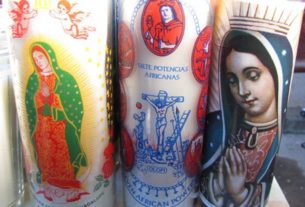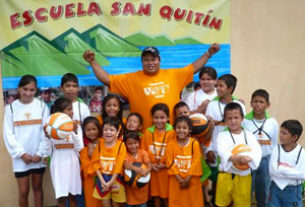Mexican Kitchen
Perhaps the most distinctive characteristic of Oaxaca is the tremendous difference between one region of the state and another. The sierras which crisscross it form natural boundaries between enclaves of culture which have existed since pre-Hispanic times. One of the most unique and charismatic of these is a group known as istmeños, inhabitants of the Isthmus of Tehuantepec.
The original Isthmus dwellers, whose remains have been dated back to 4,000 BC, were the Olmec ancestors of the Huaves, who were displaced by the more numerous Zapotecs. By 500 AD the southern Zapotec kingdom had become a trade corridor between the great civilizations of the Mexican highlands and the Mayan civilizations of Chiapas and Guatemala.
During the time of the Aztec Empire, the Zapotecs held off their would-be conquerors for so long that the emperor finally gave his daughter’s hand in marriage to the Zapotec king as part of a peace agreement. During the Spanish Conquest, many istmeños fought hard to stop the Europeans from occupying this strategic area between two important bodies of water.
Connecting the Pacific Ocean and the Gulf of Mexico, the Isthmus is only a little over one hundred miles in width, a lush tropical lowland watered by rivers which run down to the sea. Groves of mangos, oranges, almonds and coconuts are laden with fruit. The local avocados, along with those from Chiapas, are among the largest and tastiest grown in Mexico, reflecting the fertility of the land.
The sea is also kind to the istmeños, yielding enormous quantities of the fish and shellfish which dwell offshore. Mullet, flounder and shrimp are so plentiful that often most of the day’s catch is either salted or smoked, after local restaurants have bought their share of fresh fish.
The abundance of fish, fruit and fertile farmland is reflected in the expansive lifestyle of the people. Known for their fiestas, called velas, of which over one hundred a year are celebrated in the barrios of the towns of Juchitan and Tehuantepec, the istmeños form a matriarchal society, in which the women run the markets and the men who are not employed as farmers or fishermen, stay home with the children and older people.
This dominance of women, both in the marketplace and in the social structure, is unique in Mexico and fascinating to watch. A trip we took to the ancient Zapotec bathing springs of Tlacotepec and Laollaga, still clear and refreshing, coincided with the vela of Santiago Laollaga, during which we watched women at one of the barrio fiestas dancing with each other, while the men sat on the sidelines, clearly their place. Large and stately, dressed in their finest huipiles and floor length skirts, the women, obviously enjoying the admiration of the onlookers, moved with rhythm and dignity to the beautiful strains of the Zandunga.
The womens’ everyday regional dress is only slightly less exotic than that worn at the velas. The sight of the embroidered huipiles, long rabona skirts, glistening gold jewelry and floral hair adornments adds to the already exotic appearance of the Tehuantepec and Juchitan markets.
The variety of food found in these markets is extensive, confirming the impression that the Isthmus, which has been called the “Land of Plenty”, is indeed blessed with a profusion of culinary resources. Wild animals such as birds, iguanas and armadillos, used for tamales and stews, are sold along with pigs and chickens, fish and shellfish.
The huge piles of shrimp, especially in the Juchitan market, resemble pink mountains. Shrimp not needed for use that day are boiled right in the seawater after being caught, and left to dry out. They are the basis for a variety of prepared food items sold in the markets, such as caldos – soups – and gueta bínguí – shrimp croquettes.
The smoked mullet is another of the popular prepared foods, as is the marinated and cooked chicken and pork. On days when we planned a trip to the countryside, seashore or mineral springs, we got to the market early and bought a selection of prepared foods to take along for picnic fare.
Our picnics also included the local cheeses, especially those made with red and green jalapeños, and the delicious cornbread made with ground fresh corn kernels and baked in large sardine tins. Homemade pickled fruit and vegetables, sold in jars, were good accompaniments to our other picnic food.
The spices sold in the markets were quite reminiscent of those sold in markets of the Yucatan, especially the achiote pastes, which are used in a similar way in chicken and pork marinades.
In addition to the market buildings themselves, we explored street markets. In Juchitan, every day is market day, with vendors filling the streets around the market with fresh produce. Buying and selling in this area reaches a fever pitch on Sundays, with the whole town filling the market and the adjacent plaza.
In Tehuantepec, tianguis – street markets, named for the Nahuatl word for “awning” – are held on Sundays and Wednesdays. We rode to the Wednesday market on the north side of town in a motocarro, a three-wheeled motorcycle with a small flatbed built on top of the rear wheels. The tehuana women riding in them make a memorable sight, with their long skirts billowing out behind them, on their way to the tianguis.
This particular tianguis featured an assortment of goods from Chiapas and Guatemala, including non-food items. It was the farthest north we’d seen the great, colorful Guatemalan bath towels, and took the opportunity to buy one to add to our collection. We also purchased a Chiapan molcajete (mortar) and texolote (pestle) for grinding spices.
A trip to the beach revealed the source of the market’s bounty, at least in the fish department. The Gulf of Tehuantepec is dotted with small beach communities where the city folk to go get away. Along the coast are several small seafood restaurants, featuring the catch of the day. Women with baskets of freshly caught fish balanced on their heads go from restaurant to restaurant vending their wares, which turn into the star attractions of the day’s comida.
As usual, we traveled with a large cooler, and got home to the highlands with a variety of cheeses, spices, fruit and smoked fish. Best of all were the recipes we brought back from markets, restaurants, and new acquaintances. People were eager to share their regional recipes and family specialties, some of which follow. Try them and share a taste of Tehuantepec with your family and friends.
- Pollo del Mercado Juchiteco: Juchitan Market-Style Chicken
- Camarones al Ajillo de Mariscos d’ Marlo: Mariscos d’Marlo’s Garlic-Chile Shrimp
- Ensalada de Aguacate con Naranjo: Avocado and Orange Salad
- Pan de Elote del Istmo: Isthmus- Style Corn Bread


